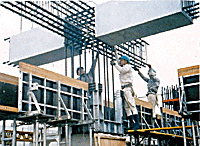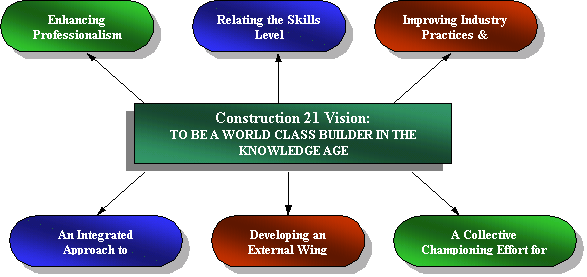
Buildings are often conceived as boring and static. In turn, the construction industry is viewed in the same light. However all these ideas are about to be overturned as there is a changing nature of the construction industry at the workplace. Design and construction has become more integrated, client organisations are recognizing the benefit of closer teamwork. Hence in short, building construction management will involve complex, detailed management of people and physical resources necessary to successfully design, develop, construct and operate residential, commercial and public properties. All these in turn affect the whole population, in terms of health and well being as it is the environment we are dealing with.

The construction industry is the major contributor to the
economic health development. Over last 5 years, the industry accounted for an
average of 8.2% of Singapore GDP for the first quarter of 1999. The construction
industry has an important role in development of Singapore’s infrastructure,
hence allowing Singapore to claim a seat as one of the best cities to live in.
Over the past 2 decades, construction sector has contributed significantly to the Singapore economy. With the maturity of the sector, combined with the sustained growth of the region, demand for specialist and R&D services is expected to rise. More importantly, the region (Southeast Asia) is at a stage of development where it is no longer practical to wait for new technologies to be created in the developed nations before they can be applied here. In particular, in areas where the application of design and construction technologies require sound knowledge of and experience with local and regional environment and climatic conditions. All this points to one factor, is that we require our own professionals in this area and growth of industry can be achieved further.
![]()
Future of the Construction Industry
Opening speech of BCA (Building and Construction Authority) deputy Chairman, Tan Kian Hoon at a seminar on “Bring Construction Industry into Cyber Age”, he urged the construction sector to seize the opportunities made available by cyberspace and not to miss the emerging trend. This indicates the opening of space for further growth and development.
![]()
Construction 21
Summary
of how Construction 21 can be implemented to re-invent Singapore Construction
Industry.
May 1998, Construction 21 study was started
1. To address problems in construction industry
V Heavy reliance on unskilled foreign workers
V Low productivity
2.
To address issues across the construction value chain from design to
construction to maintenance
Construction 21 Steering Committee and its four Working Groups include representatives from major industrial players.
Past year activities at Construction 21
V Discussion of key aspects of industry
V Looking to other countries on how similar problems were solved
Unique problems
V Negative productivity growth since 1995
V Past 4 years, productivity level dropped by more than 13% (due to heavy reliance on unskilled foreign workers)
Singapore construction industry lags behind Japan, USA, Australia
Need for major transformation of industry for better resource utilisation, efficiency, reduce wastage and social costs.
Vision of Construction Industry in 21st Century
“To be a World Class Builder in the Knowledge Age”
Industry is to be turned from a Dirty, Demanding and Dangerous (3D) Industry to a Professional, Productive and Progressive (3P) Industry.
All this requires a Knowledge Workforce.
Turning Vision Into Reality: Six Strategic Thrusts
 |
![]()
Conclusion
Although the industry has been changing over the past 3 decades, it has not yet achieved optimum development. However all these are about to be changed, as Singapore steps across to a knowledge economy, the construction industry will develop in accordance. With the vision crafted and strategies given, the industry will not be able to address its present problems but be able to have breakthroughs and attain world-class standards befitting of a global city.
![]()
![]()
![]()
![]()
![]()
![]()
![]()
![]()
![]()
![]()
![]()
![]()
![]()
![]()
![]()
![]()
![]()
![]()
![]()
![]()
![]()
![]()